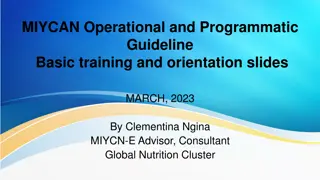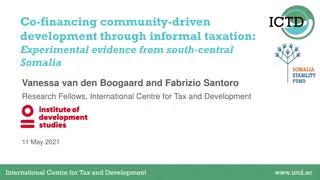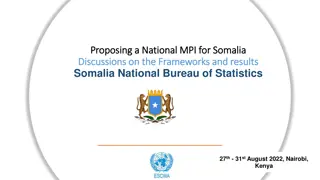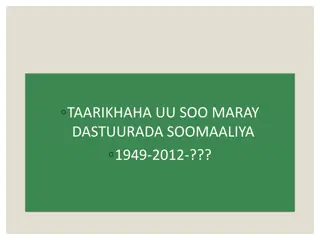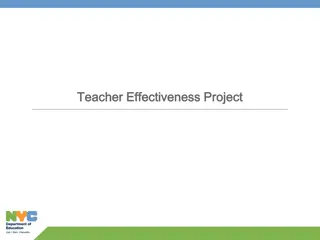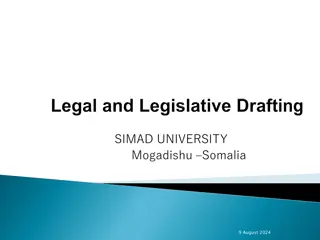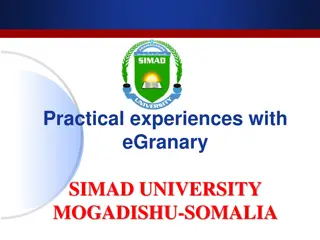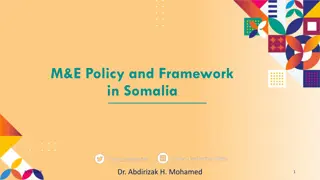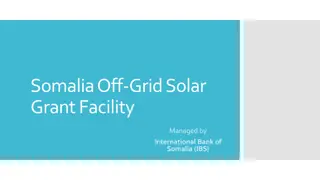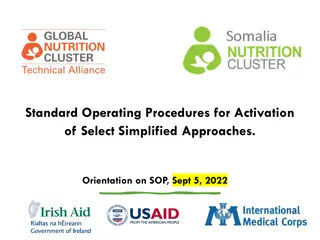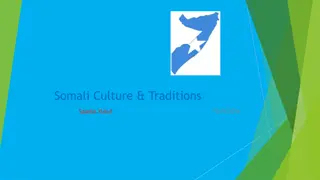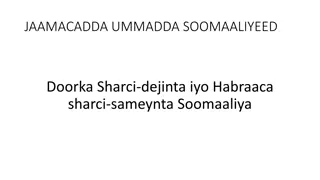Evolution of Teacher Training in Somalia
Explore the historical progression of teacher training in Somalia from early institutions to modern education programs. Understand the impact on teaching quality and education systems.
Download Presentation

Please find below an Image/Link to download the presentation.
The content on the website is provided AS IS for your information and personal use only. It may not be sold, licensed, or shared on other websites without obtaining consent from the author.If you encounter any issues during the download, it is possible that the publisher has removed the file from their server.
You are allowed to download the files provided on this website for personal or commercial use, subject to the condition that they are used lawfully. All files are the property of their respective owners.
The content on the website is provided AS IS for your information and personal use only. It may not be sold, licensed, or shared on other websites without obtaining consent from the author.
E N D
Presentation Transcript
Objective To describe the current status of teacher s qualifications, salary scale, professional development of teachers, and deployment to understand the importance of the teaching profession to the quality of basic education in Somalia.
INTRODUCTION The teaching profession is necessary as teachers required to teach students with different needs and abilities. The National Teacher Policy states that teachers are central to quality and equitable education delivery.
INTRODUCTION Pre-Independent In Somalia, teacher training was established in 1946(Sheikh, and Magistale) which offered a one-year pre-service and in- service training program for intermediate school leavers. In the 1950s, an effort was made to train qualified teachers at home and abroad. Magistarle(Teacher training in Mogadishu) started pre- service training for the duration of two-year 1952 Takhasus (specialization) was another teacher training in Mogadishu that provided four-year intermediate education and a two-year teacher training course to prepare Arabic teachers.
INTRODUCTION 1960-1969 In 1963, National Teacher Training Center (NTEC) The South and North teacher training centers stopped training new pre-service teachers in 1965, 1967 and 1966, respectively In 1968, NTEC became a college of education to train secondary graduates for four-year teacher education courses to obtain a Bachelor of Education.
INTRODUCTION 1970-1990 NTEC program was two-year, from 1976 to 1982, to produce enough for secondary schools teachers. 1972 -1975, a two-year primary teacher program was established within the college of education(NTEC). In 1975, Halane Teacher Training Institute was established in Mogadishu to address the problem of a shortage of teachers. The initial training duration was one year after completing primary, but it was expanded into two years from 1978 to 1984.
INTRODUCTION 1991 to present Amoud and Mogadishu University were the first institutions to offer a diploma or bachelor of education. This was followed by various universities that started a bachelor of education. In 2005, Garowe Teachers Education College(GTEC) Somaliland National College of Education(SNCE), Jubaland Teacher Training College(KTTC), and other teacher training in Mogadishu and others. The first in-service teacher training was done in 2006 in Puntland and Somaliland under the SCOTT project.
Issues Shortage of qualified Teachers The shortage of teachers was a major issue faced by the ministry of education in the 1960s. In 1962, it was reported that 112 of 201 intermediate and secondary school teachers were expatriates. In 1968-69 some reports estimated that 50% of elementary teachers were unqualified. In the 1980s, qualified teachers and the quality of education in Somalia declined(66%).
Research Design Data type Data Source Analysis Methods
Findings 59% and 49% of female and male primary school teachers earn below 100 US dollars per month. Puntland state pays the salary of some teachers in public schools at 56.45 USD dollar per month as the state salary contribution. Lack of salary grading system The government pays less than 20% of salary of primary teachers(B4S)
Findings Unstandardized curriculum and programs Inadequate fund Poor quality assurance system Lack of coordination Weak capacity
Findings Deploying teachers to schools is not equitable(MoECHE, 2022) 64% and 63% of teachers in Somaliland and Puntland work at urban areas, respectively
Discussion Qualified teachers lack pedagogical skills as a result of unstandardized teacher education programs in Somalia. A skill deficiency in the teaching profession has resulted in either poor teacher training programs or unqualified teachers in teaching services. The skills gap limited the teaching profession and learning outcomes.
Discussion The current salary scale of teachers, particularly in primary teachers and rural areas, is an issue related to poor learning outcomes. Absent of a salary grading system and lack of linkage between salary and qualification of teachers demotivated the performance of teachers and dismissed the teaching profession.
Discussion The most obvious challenges in teacher training in Somalia include a lack of harmonized teacher training programs, a poor coordination and certification system, limited capacity of institutions, inadequate funding, and the absence of interest of secondary graduates to pursue teacher training programs.
Discussion Another significant issue is the deployment of teachers in schools or regions, as it may cause a given school or area to have more qualified teachers than others. In summary, this allows unqualified teachers to enter the teaching service and remain in the teaching service.
Recommendations Teacher Education Policy addresses more issues on teacher education, so it must be fully implemented and disseminated. Harmonizing teacher training programs and reviewing teacher education policy and curriculum to equip teachers with the necessary skills, knowledge, and values, as demanded for teaching today Teacher deployment should be addressed by offering salary promotions and professional development training for rural teachers Allocating enough salaries for teachers, particularly female teachers, that make teachers perform well and retain workplace through the creation of salary grades linked to teachers' qualifications and experience
Recommendations Improving and coordinating teacher training institutions, and conducting research on the teachers supply and demand to address shortage of qualified teachers. Developing effective strategic for reducing/eliminating unqualified teachers through effective teachers training progress.





